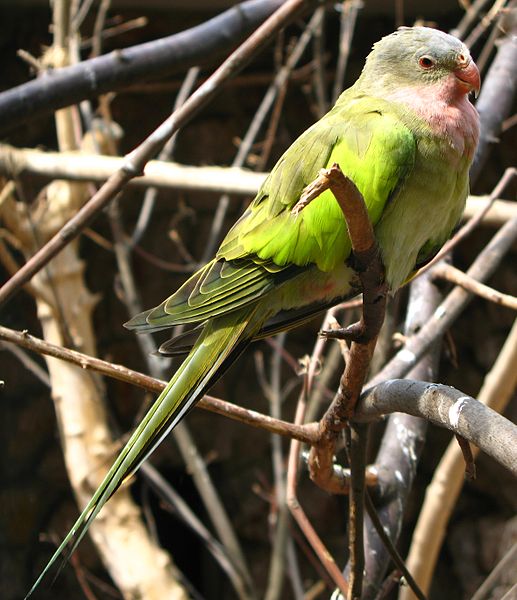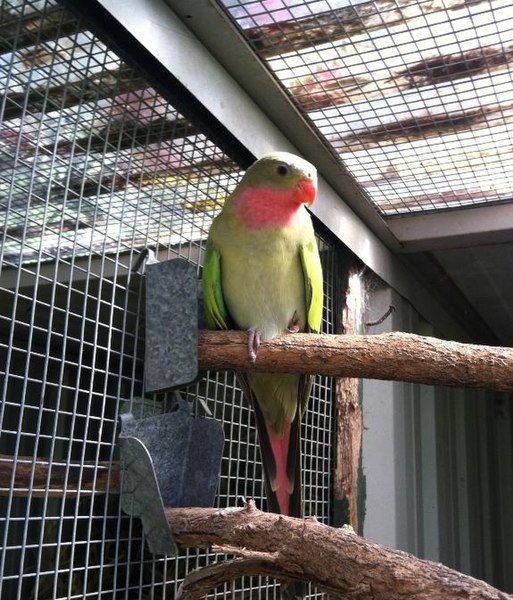Princess Parrot Facts
- Life Span: ~ 15-30 years
- Body Size:
- Male: 46.5cm – 48cm
- Female: 39.5cm – 41cm
Princess parrot Body Weight
- Male: 120g
- Female: 110g
Princess Parrot is probably one of my favorite Australian parrots of all time.

They have pleasant characters, in both aviary and indoor hand-raised situations. Their coloration is another great factor as to why anyone will love the princess parrot.
They are very easy to care for, and have the capacity to learn to whistle and talk. There is no difference between which sex is better to have as a pet because they are both very affectionate and highly curious birds. So beware if you leave them running around the house without supervision, as the chances are very high for them to get into trouble.
Sexing: Princess Parrots are sexually dimorphic, meaning both males and females can easily be determined by observing the different feather coloring. Males tend to have a more pronounced blue patch on the nape of the head, and darker pink on the throat. A different shade of blue feathers above the rump can also help determine sex.
The rump in males tends to be a darker blue, while the females tend to have a lighter sky-blue color. Mature males tend to have a small lobe that extends off the primary flight feathers. The iris in mature males has more of an orange color as hens have a slightly browner appearance. Finally, the most striking difference in males is their beautifully long and elegant tail, if compared to the hen’s tail which is shorter.
Male: The nape of the head is blue, while the back of the head and neck appear to have a greyish-olive-green color. The back and outer tail feathers are an almost yellowish olive coloration, whereas the majority back parts of the wings are a stunning light although bright green. The outer flights are typically a mix of bluish, and grey with a hint of green merged into one color. The rump has a beautiful dark purplish-blue coloration that extends halfway up to the back. The throat region is dark pink, while the chest and body parts are light green. The undersides of the tail feathers are pinkish, with the feet a brownish color and the nails black. The beak is a dark orangeish-red color, while the eyes have an orange iris and black pupils.
Female: Very similar to the male, except the hen does not contain the extra long tail feathers, nor does it have the lobes on the flight feather when mature. The hen’s beak is usually slightly less pale in color and does not contain the bright orange iris and the full amount of blue on the nape of the head. The back of the rump coloring is slightly less dark in blue.
Young Birds: Young Princess Parrots look very similar to the hens, although they have a black eye color. This eye color will change once the bird matures. Young males will get their lobes around the ages of 1.5 to 2 years. At this age the males will be sexually mature, with full feather plumage, and ready to breed. Extra plumage coloration especially the blue on the nape of the head. A darker blue on the back of the rump, orange iris coloring, and a brighter green patch will also be seen at this time.
Types and Hybrids: There are a couple of color mutations for the princess parrot. These color mutations are blues, lutinos, and albinos. Princess Parrot is a very adaptive bird, thus has been hybridized with the Superb Parrot, Crimson Winged Parrots, and Indian Ringnecks.
Distribution: Typically Princess Parrot is seen in areas of Australia from inland Western Australia extending to inland South Australia and the Northern Territory.
Princess parrot breeding
Princess Parrots are relatively easy to breed in any aviary setting without hostile birds.
They will breed quite well and may breed at any time of the year in a mixed setting, although I have found they breed better in an aviary to their own species. I have experienced second hens, forming a trio helping another hen feed, and looking after chicks.
A common complaint if any for Princess Parrots breeders is during incubation the hen jumps onto the eggs and breaks them. Because of this different shapes of breeding boxes have been designed to reduce this phenomenon.
Princess parrot supplies
- Eggs per clutch: 4-6
- Incubation period: 21 Days
- Nest box size: There are a couple of different types and sizes of nest boxes breeders may use for princess parrots.
High Parallel nest boxes, should contain ladders inside for the birds to walk down to the basement of the breeding box so the eggs are not damaged from birds jumping. Princess parrots are noted to be a bit clumsy, and most breeders will keep away from these boxes. Personally, I have never experienced any problems with these boxes. A typical nest box would house at least 2-3 adult birds. This allows an adequate size for adults plus babies to grow. I just prefer to give birds the room if I am able to. Height x 600cm Width x40cm Depth 40 cm.
“L” shaped boxes Ver. 1 and 2, are medium-sized measuring approx. Height x 600cm Width x40cm Depth x 600cm. level under the door can have a flap for easy inspection.
“U” shaped boxes are approx Height x 600cm Width x 800cm Depth 40cm.
Princess parrot care
Princess Parrot is an absolute delight to have in any avian setting. They are easily adaptive, very friendly, and highly curious types of birds. A strict worming program every three months in Australian conditions is recommended for princess parrots. The main reason for this is Princess Parrots love to explore the ground and feed off the ground as much as exploring other parts of the aviary. Thus often birds kept within an aviary setting that is not wormed frequently defecate on the ground and eat from this same floor area. Providing a perfect routine of worm infestation time after time, until eventually, the bird is so full of worms it dies through intestinal blockages or other intestinal-related problems.
Obviously, birds that are housed in suspended flight aviaries are not going to be in such direct contact with fecal matter, thus reinfestation of worm eggs is greatly reduced. Many people are often unaware of this problem regarding worms, typically “roundworms” and often they may find their Princess Parrots simply “Drop Dead”.
Although in most cases upon Autopsy the findings are in more cases than none are related to a mass infestation of worms within the intestinal tract. Now that I have made you aware of this important fact, I now need to inform you of another typical scenario that I have heard many times, extending from worm-infested birds. People that do not maintain a strict worming program with their birds are putting their birds at even more risk of death-related incidents to worms.
This is because usually if left after a long period the number of worms inside the intestinal tract increase. In this circumstance when this happens and the bird is wormed, all the worms are likely to die at once causing a fatal intestinal blockage. This might all sound really complicated, but it’s really simple. Depending on what worming solution you are using will depend on how you worm your bird.
The best person for advice for an adequate worm regime is your local avian vet. I personally use a slow-acting wormer first typically a sheep wormer “Panacur” because it normally targets just roundworms. Two weeks later I use a standard avian wormer. After the worming, I use a high-water pressure spray with disinfectant to clean the floor. This helps kill and remove any worm eggs on the floor. If you are keeping a soil-type floor, definitely keep a good worming program and change the soil often.
Princess parrot cage
The only disadvantage of breeding a princess parrot if it is desired to keep a hand-raised bird in the side is they will need a large cage, because of their very long tail. So for some people, their cage is large in size and will cost more and may inhibit some to purchase such beautiful birds as pets, just because of the initial costs involved.

Princess parrot Feeding and Diet
Princess Parrots in the wild are Spinifex grazers, So it stands to good reason they require small seeds within their diet. In an aviary setting, a diet consisting of a Lovebird/Cockatiel mix with fresh fruit and vegetables is excellent to maintain great health for your birds. Optional pelleted diets may also be supplied, as they are very inquisitive birds, and it will not take long for them to accept new foods.
Princess parrot noises level
A pretty pleasant chortle, while not excessively loud, can still be heard for some distances. Usually, they whistle a lot with new birds around their aviary, in the early mornings and late afternoons before roosting.
